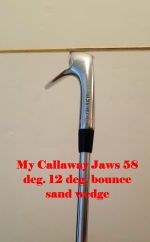January 26, 2021
What bounce is right for your sand wedge?
 Gene Sarazen is credited with the invention of the modern sand wedge in the early 1930's. Actually there were previous efforts, but it was Sarazen that perfected the design and playability. The story goes that while learning to fly an airplane, Sarazen noted the plane's tail adjusted down during takeoff and created lift. This gave him an idea to solder metal to the bottom of his highest lofted club at the time. He experimented with numerous designs and eventually came up with a club that is remarkably similar in loft, sole, and bounce to the modern sand wedges that experts like Roger Cleveland and Bob Vokey design today. Sarazen's wedge had 58 ½ degrees of loft and a bounce of 13.5 degrees and is on display at the USGA Museum.
Gene Sarazen is credited with the invention of the modern sand wedge in the early 1930's. Actually there were previous efforts, but it was Sarazen that perfected the design and playability. The story goes that while learning to fly an airplane, Sarazen noted the plane's tail adjusted down during takeoff and created lift. This gave him an idea to solder metal to the bottom of his highest lofted club at the time. He experimented with numerous designs and eventually came up with a club that is remarkably similar in loft, sole, and bounce to the modern sand wedges that experts like Roger Cleveland and Bob Vokey design today. Sarazen's wedge had 58 ½ degrees of loft and a bounce of 13.5 degrees and is on display at the USGA Museum.
Image having to hit out of sand with a niblick (about 45 degree loft) with no bounce and a thin sole! The technique at the time was to pick the ball off the sand or blast down behind the ball. The skill level to pick a ball off the sand is extremely difficult and made playing out of bunkers truly a hazard before the advent of the sand wedge. Because there was no bounce, if a player hit a little behind the ball the club would just bury and stop. The modern sand wedge has made this particular shot much easier.
What Gene Sarazen really did was introduce bounce to golf club design. Most irons have varying degrees of bounce in their construction. Most professionals want less bounce and a clean leading edge so to make contact first with the ball. Player improvement irons have more bounce through the set, so the higher handicap golfer doesn't have to be as precise landing at the ball. Bounce is measured by the angle created between the leading edge and the lowest point of the sole. The more bounce the less the club will dig into the ground.
Wedges starting at 50 degrees through as much as 64 degrees have a bounce factor that should be considered based on your swing type and what you want the club to perform. Personally I don't think the average player needs a sand wedge higher than 56, however a 60 would be the maximum I would suggest. The higher the wedge loft, the longer the swing and therefore harder to be consistent. Leave those for the Phil Mickelsons of the world. By adjusting face angle and hand position, you can create the same shots with a 56 degree wedge as a 60 degree wedge.
There are basically two wedge swing types, the steep swing and the sweeping swing. Each swing type will dictate the amount of bounce you should have on my wedges. First you need to know what type of swing you enjoy using. Take at least 10 balls and from a closely mowed area and hit 30 to 40 yard shots with your sand wedge. Note what kind of divot you make. If you are just brushing the grass or have shallow divots you are a sweeper. If the divot is deeper your angle of attack is steep. The steep swing needs more bounce to prevent too much digging into the ground or sand. The wedge you use out of the sand should have a wider sole and at least 12 degrees of bounce. If you are a sweeper, you would be happier out of the sand with 8 to 10 degrees of bounce and a standard medium wide sole.
Sand wedges are not just for sand, but for a variety of shots around the green. Most people use their 56 degree wedge for sand which has the most bounce. If you have a 60 degree the recommend bounce can be from 4 degrees to a max of 10 depending on your swing type. 50 degree and 52 degree wedges are gap wedges and are usually full to ¾ quarter swings. For those an 8 or 10 degree bounce is pretty standard.
If you want to be a more consistent wedge player around the green, learn to be shallower with your wedges off the grass. Contrary to your full shots, you don't want to lead with the leading edge into the ball and ground, but to land a bit behind the ball with the sole of the club hitting the ground first! Professionals rarely take divots playing these shots, they use the bounce to give them spin and control. I see many amateurs playing their wedges too far back in their stance and leaning the handle way forward so to make sure they hit the ball first. This is exactly opposite to what the best wedge players do. The shaft should be straight up and down with a little forward lean of the shaft. Let the club rest on the sole and bounce of the wedge and return the club to the same position at the impact position. On these shots you actually want to hit the ground slightly behind, to as much as an inch, behind the ball. The construction of the wedge will slide the club under the ball and produce the desired result. Because this is a shallow swing, you must not stop, but swing through while turning your body.
If you are having trouble in the sand or short wedge shots, you might have the wrong equipment or the wrong swing and setup to accomplish your task. Change your technique or add more bounce to your wedge. Bounce is your friend, use it to your advantage and thank Gene Sarazen for the help.



